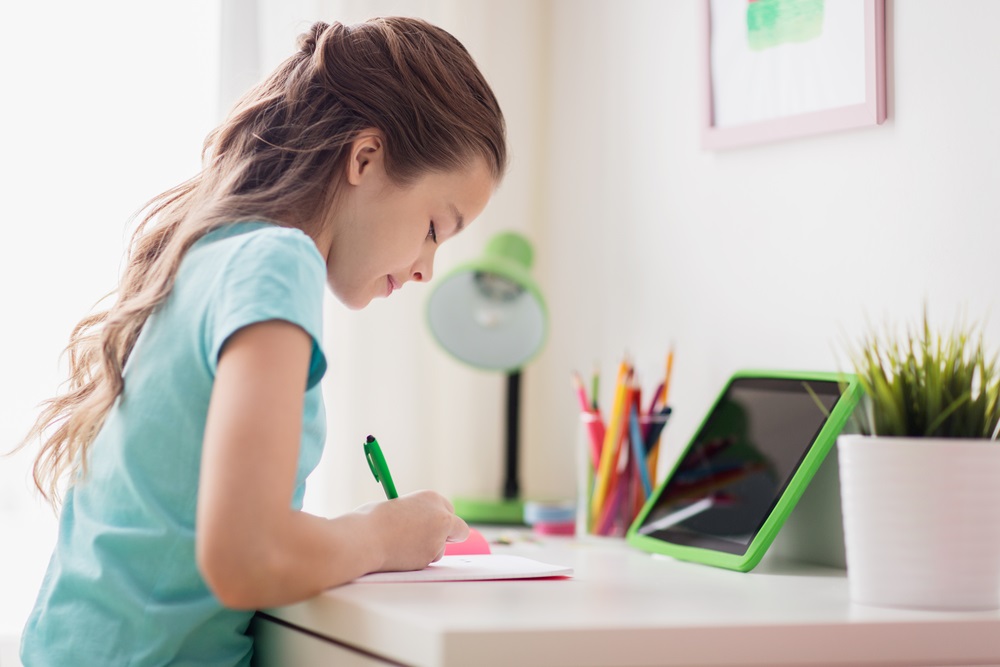Teaching your children at home can be an immensely rewarding experience. One of the reasons that many parents choose to homeschool their kids is that they feel they can provide a better education for their children than either a public or private school. To provide an outstanding education for your children, you will need to provide an environment that fosters learning. Power Homeschool has a few tips for creating a learning environment at home for your children.
1. Make a Special School Space
While it can be tempting to set up shop at the dining room table or on the couch, these areas aren’t the most conducive to learning. Creating a dedicated learning space can make it easier for children to concentrate on schoolwork.
When it comes time to make a special place just for school, consider a room that is large and open. Consider what all you will need in the room. You will need a place for students to work; often, parents choose a table or desks. Learning centers are important for homeschooling environments, and bookshelves are a great place to store reading and learning materials. Don’t forget that you will need a lot of storage space in this room, so you are going to need a lot of room for everything.
Think about the amount of light you have in your space. Windows are great for natural light, but it isn’t always bright and sunny outside. Make sure that you have light fixtures that will keep the room bright enough on dark, gloomy days, too.
This dedicated space should be used for schoolwork and not outside activities. You don’t want the room to double as a playroom, because you might notice that kids stop focusing as well. You might also notice that supplies dwindle or vanish when the room is used for play or other activities.
2. Make Your Space Comfortable
Does the room that you are thinking of using for your homeschooling lessons have good airflow? Is the space well-insulated? You won’t want to choose a space that is hot in the summer and cold in the winter. If you choose a place like a converted garage or basement, make sure that you can control the temperature in the area to ensure that everyone is focused on their schoolwork instead of their discomfort.
If you know that your homeschooling space gets cold in the winter, consider investing in a quality space heater. Vice versa, if it is warm in the summer, you might need extra air conditioning power or a good fan to circulate air through the space.
Windows that allow natural light into the room can be beneficial, but you might want to install blinds or curtains if the room is in direct sunlight, as direct sunlight can make the room very warm.
Not all kids like to sit in a chair all day. Have different seating options in the room to make the space more comfortable for those who want to sit on the floor or on a beanbag chair. You could also offer yoga balls for deskwork.
Noise can be a big distractor for kids. Try to make sure that your learning environment at home is quiet. If your kids do better with soft music, that can be an easy way to drown out some of the noise you may otherwise find bothersome.
3. Make Your Space Fun
Traditional classrooms often have posters and other fun things on the walls to create a more inviting space for students past the tile floors and beige walls. In your home, you can make your schooling space as colorful and fun as you would like. In fact, you can even get your children involved in the decorating. Use a lot of colors to make the space unique and fun.
A few ideas for making your classroom a fun place for the kids includes painting the room a soothing color or add an accent wall. You can also incorporate color with furniture, a rug, and throw pillows. Hang student artwork on the walls and put up fun, educational posters.
Don’t forget that learning should be fun. When possible, use toys as teaching tools. Not only will this make learning more enjoyable, but it will add a bit of whimsey to the room as well.
4. Create a Place for Supplies
The worst thing you can do is forget to make an area for the basic school supplies. If your kids have to go on a five-minute hunt every day for a pencil, that will eat away at precious time and cause a big distraction. Make sure that there is a well-stocked supply station in your classroom to avoid constantly searching for simple things throughout the day.
You can keep things like rulers, staplers, markers, and other items that might not be used as often in a supply cabinet or station. Get creative with labels and keep the space organized.
5. Add Teacher Items
Don’t forget to create an area for all of the teacher items. You don’t want to have to carry your own supplies all over the house. If you want to keep your supplies separate from the regular classroom supplies, then make your own little space in the classroom. If you have your own desk, you can store most of your things in your desk for safekeeping.
There is a reason that chalkboards and markerboards are placed in classrooms. They make life a lot easier for teachers and students alike. Consider getting one or the other to use in your schoolroom. If you really want to get creative, you could use chalkboard paint to make a wall your chalkboard.
6. Don’t Forget to Get Out of the Classroom
While you will likely spend a lot of time in your homeschool classroom, don’t forget to take the opportunity to get out of the classroom from time to time. Maybe you do class outdoors on a nice day. Perhaps you can do a lesson in the kitchen or do some reading on the couch. You may even be able to get out of the house altogether and learn while in the park or at the grocery store. Find ways to keep things interesting by getting out of the classroom at least a couple of times a month.
Some homeschool parents create a little area outside to use on nice days. Get quality furniture that your children can do schoolwork from. We recommend getting solid furniture so that the tabletop can be a good writing surface.
You can also take the time to plant a garden to use as a lesson and a fun place to go when it is just too nice to sit inside during the day.
While it is a good idea to get out of the classroom occasionally, it isn’t a good idea to allow your children to complete their work in their bedrooms frequently. A lot of distractions can pop up in their bedroom, which isn’t going to be conducive for their education.
7. Leave Time for Breaks
Nobody likes working for extended times without a break. When your kids start to get restless or hungry, it might be a good idea to create a scheduled break. Maybe you need to take a morning snack break and an afternoon exercise or play break a couple of hours after lunch. When you are first getting started, you might start to notice good times for these breaks, and then you can start scheduling them into your day.
While some children might require frequent short breaks, others might like only one or two longer breaks. Read your children and let them help create your schedule in this matter.
8. Keep the Room Clean
Clutter and stray items can be distracting for young learners. Try to keep out only what you are using for the day; everything else can be stored until you need it next.
Organization will be your friend as a homeschool parent. Keep lessons and activities sorted by topic and age. This will help you take out only what you need for any given lesson.
At the end of the day, get everything picked up and put away. You can have your children help in this task regardless of age. Teaching your kids to put away items when they are done with them is a great way to make sure that your classroom doesn’t get really messy.
To learn more about homeschooling, visit the Power Homeschool website. We offer an online homeschooling program for students from kindergarten through 12th grade.
Related article: Tips for designing an indoor learning environment



Thanks for your awesome article. Even as schools open, many are still using a mix of synchronous and asynchronous teaching, so that proper place to learn while at home is certainly critically important.
I’m considering to subscribe my child to this program it seems very interesting ?